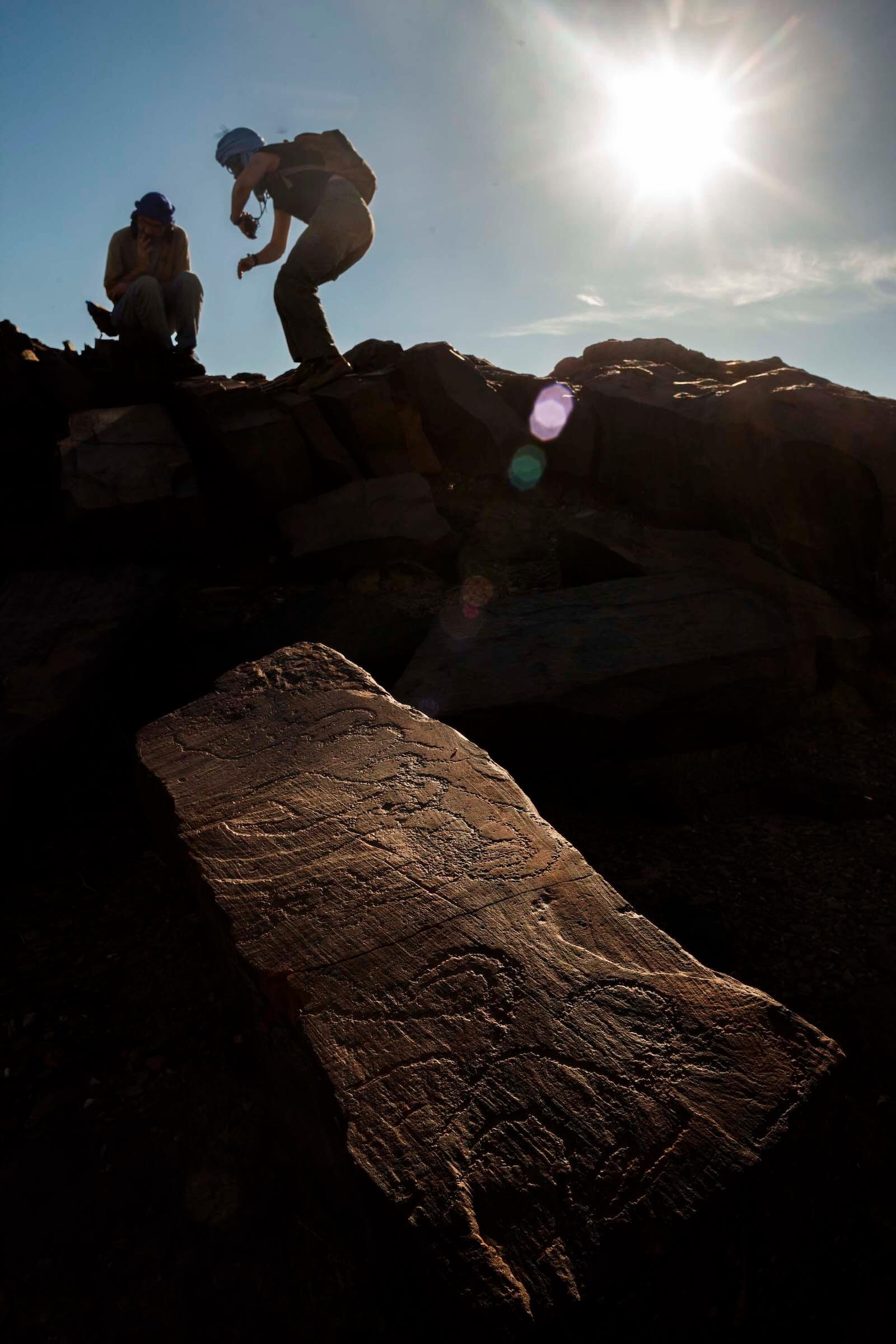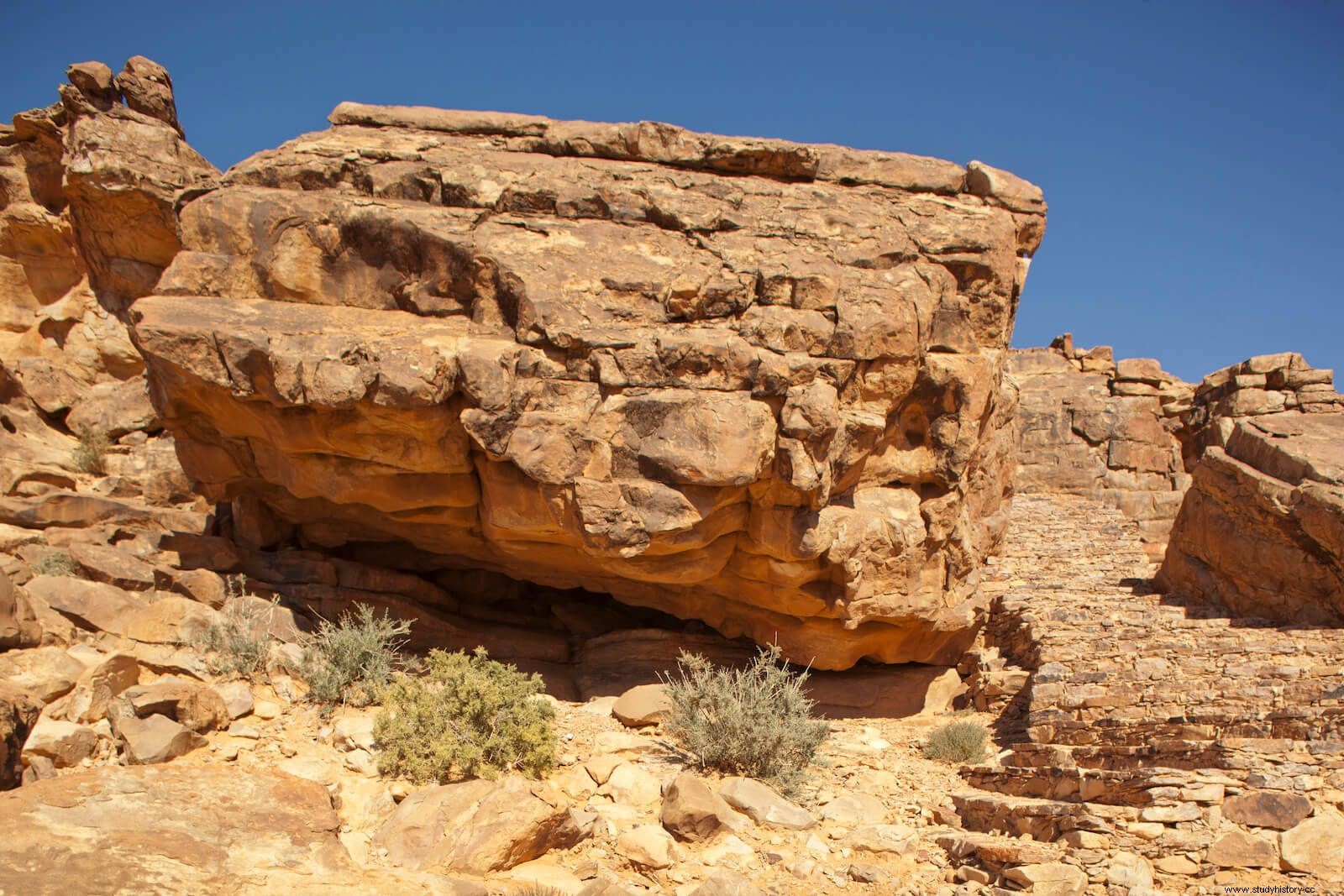
In the south of Morocco we located important cores of engravings made on stone blocks or vertical walls and, more exceptionally, of paintings executed in rock shelters. Since 2011, the Tamanart Team is investigating these artistic representations, considering their natural and cultural environment, from an interdisciplinary perspective that includes archaeological, ethnographic, geological, petrological, cartographic, topographical, traceological and technological, physicochemical studies (analysis of pigments, possible binders and patinas or supports , absolute dating...) and paleobiological (animal species represented), having participated in them numerous institutions and companies. We start from an exhaustive digital photographic documentation, as well as macro and micro, of all the figures, compositions and panels, made day and night, with natural and/or artificial lighting, which is treated in the laboratory through the programs considering their georeferencing, in order to obtain objective reproductions. The fieldwork focuses on Tamanart (Tata and Tiznit) (engravings) and Aouinet Azguer (Tan Tan) (paintings) and their protection, conservation, enhancement and dissemination are also considered.
The Oued Tamanart , 84 km long, runs from north to south and flows into the Draa, the largest wadi in Morocco. We know, in the Tamanart valley, more than thirty sites with manifestations engraved on sandstone or quartzite supports, as well as innumerable burial mounds, of uncertain chronology, concentrations of lithic industry on the surface, dating back chronologically to the Lower Paleolithic and Medium , ceramics and decorative elements, among which are perforated ostrich eggshell beads.

The theme of these representations is elephants, rhinos , giraffes, aurochs or bulls, antelopes, gazelles, goats, camels, horses, cheetahs, lions, ostriches, bustards and other indeterminate zoomorphs. The anthropomorphs of the last phases are associated with chariots and axes. Also noteworthy are the schematic, abstract or geometric shapes (circular or globular, angular, grids, zigzags, spirals, cups, meandering, groups of lines, combinations of elements...). The engravings, of different styles and sizes, are made by incision, abrasion, scraping and picket, overlapping in certain cases and defining a wide temporal sequence.
The Atlantic band of the Sahara did not have to share the climatic extremes of this great desert. Historiography has referred to topographic corridors or refuge areas to explain the settlement of this area and its circumstances, also related to fauna, in certain periods during Prehistory. In the south of the Tamanart, where it flows into the Draa, a large wetland would probably have been formed since the end of the Pleistocene . We are in Tachokalt and Anou L'Haj, places where we find a small number of representations of gazelles, antelopes, aurochs and ostriches with a naturalistic tendency and very fine lines. According to recent hypotheses, they are among the oldest representations in the western part of North Africa. These manifestations would be followed, considering a chronological sequence, by zoomorphs characterized by the disproportion or stylization of certain anatomical concepts executed by abrasion. We are facing the controversial style Tazine , typical, here, of hunter-gatherer communities.

During the Neolithic, groups occupied the valley of pastors who will recycle the previous figures and they will create a graphic symbolism determined by domesticated animals, mainly bovids and caprids, executed by means of deep picketing and maintaining a marked naturalism. Finally, the motifs that can be related to the Amazigh culture, also well represented in Icht, extend through the Tamanart, whose northern reference is found in Oukas. Anthropomorphs, weapons, chariots, horses... will constitute the iconographic repertoire, introducing the schematic trend and reaffirming abstraction. We are faced with Libyan-Berber art. The current population still preserves and reproduces beliefs and rituals that help us understand, from an ethnoarchaeological perspective, the conceptual framework of those who made the engravings during more or less distant times, highlighting elements such as bowls, whose multifunctionality is extremely suggestive.
Aouinet Azguer 1 (south of M’Sied) was discovered in the summer of 2002 by a nomadic woman, Fatimatou Malika Bent Benatta, and so far we have located twenty rock shelters. We find a theme and a long time sequence that can be linked to the Tamanart valley, especially considering the southern sites, Tachokalt and Anou L'Haj. A first chronocultural phase has been defined, whose compositions, style, technique and size cannot be related to the rest of the motifs in the area, and although these, always zoomorphic, quantitatively insignificant, present a volumetry that approximates them to a naturalistic tendency, their The definition is imprecise, although the iconographic structures coincide with those at the beginning of the graphic sequence of Tachokalt and Anou L'Haj.

The figures occupy privileged or central spaces within Aouinet Azguer 1 and 5, are outlined in red and some of the identifiable representations refer us to possible gazelles and antelopes, infraposed, when this happens, to other phases, which also indicates early chronologies. In the following stages, the zoomorphs with a naturalistic trend in flat ink stand out, with different degrees of stylization, introducing the human figure from a certain moment , male at first and female later, coinciding with the archers. Some shades of red are relatively dark and we can also see silhouetted figures with striped interiors. In the final phases, schematic representations appear (human, animal and geometric figures), cars and also motifs and inscriptions assimilable to the Amazigh culture, in red and dark red, made in flat ink and simple strokes.
The formal similarities of the representations of the first phases of Tamanart and Azguer with those of southern Europe are evident. We must ask ourselves if they obey contacts or whether communities with given cultural structures can independently create similar forms. To address this and other challenges, during 2019, we had the opportunity to start the study of Magara Sanar, a rocky shelter, near Chefchaouen. We intend to consider the Strait of Gibraltar from both shores, and complement the investigations initiated during the eighties of the last century in the mountains that border the old Laguna de la Janda (Cádiz).

The archaeological research project that concerns us has been possible thanks to the agreement signed on July 25, 2011 between the Direction du Patrimoine Culturel (DPC) of the Ministry of Culture of the Kingdom of Morocco in Rabat and the National Distance Education University (UNED) in Madrid. The granting of subsidies by the Institute of Cultural Heritage of Spain of the Ministry of Education, Culture and Sports in five consecutive calls allowed us to work in the area and carry out office and laboratory work between 2011 and 2016. From 2018, and until Currently, we have maintained this line of research with the continued support of the Palarq Foundation.
UNED:National University of Distance Education (Madrid).
INSAP:Institut National des Sciences de l’Archéologie et du Patrimoine (Rabat).
EASD Serra i Abella:Escola d’Art i Superior de Disseny Serra i Abella (Barcelona).
CNPR:Center National du Patrimoine Cave (Agadir).
IRCAM:Royal Institute of Amazighe Culture (Rabat).
Wellrounded 360º:Wellrounded 360º – Photography (Nerja).
